By the numbers:
- 290 miles, from Vicksburg, MS to New Orleans via Natchez– 3920 total miles for the trip.
- highest temp: 93 – Under the idea that it is always good to learn something new every day, we learned something new today. In response to a comment about the heat and being from Seattle at one of the visitor’s centers we were told we shouldn’t mind the heat here because we would be used to the humidity in Seattle. I have lived in a few places with high humidity including Iowa and Washington DC, but until today I did not know Seattle was one of them.
- Traveled through 2 states today: MS and LA, but no new ones.
- License plates for 3 new states today: Rhode Island and Maine. – That leaves just Vermont, New Hampshire, Connecticut, Hawaii, and D.C to spot for the trip.
- Three new national park stamps today for 2 new parks: Melrose Mansion and the William Johnson House at Natchez National Park, and The Natchez Trace Parkway. – 24 total park sites for the trip.
- Elevation number for the day – 11 – more on that below.
The Natchez Trace is another one of those interesting parts of our history about which I knew nothing before. The Trace is now a parkway which runs all the way from Natchez, Mississippi to Nashville, Tennessee.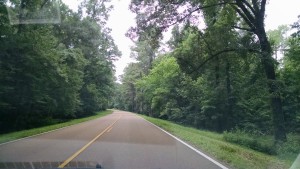 It began as a animal and game path 1000’s of years ago, then became a hunting trail, then a bit of a trading trail, but took a more permanent form in the late 17 and early 18 hundreds. Farmers and traders from the Ohio and upper Mississippi Valley who wanted to sell their goods to people in the more populated Eastern cities would bring their products down the Mississippi on small wooden boat. After selling their goods there was no inexpensive way back up the river. Many sold their boats for the wood and then walked back up to the Ohio Valley. The primary route followed was the Natchez Trace. It took as long as 30 to 40 days to walk that trail and for a time thousands of people made that trek every year.
It began as a animal and game path 1000’s of years ago, then became a hunting trail, then a bit of a trading trail, but took a more permanent form in the late 17 and early 18 hundreds. Farmers and traders from the Ohio and upper Mississippi Valley who wanted to sell their goods to people in the more populated Eastern cities would bring their products down the Mississippi on small wooden boat. After selling their goods there was no inexpensive way back up the river. Many sold their boats for the wood and then walked back up to the Ohio Valley. The primary route followed was the Natchez Trace. It took as long as 30 to 40 days to walk that trail and for a time thousands of people made that trek every year.
We are now in New Orleans and will explore the area for the next couple of days. Consider that the main part of the city of New Orleans is at 11 feet elevation. If you have ever been at an ocean beach in even a mild storm, think about how high some of the waves are that come crashing ashore. Then imagine living in a city where the street is lower than the top of some of those waves.
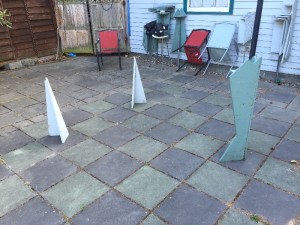 Here’s my little tidbit of thought related to elevation today. As I have said before, Louisiana is very flat. How flat you ask? Well consider this. Back in Seattle, a few years ago, I redid part of my back yard in the form of a chess board patio. The planning, excavation, building and construction was a fun summer-long project. One thing I learned is that you should never build a patio or driveway perfectly level. If you do, you will have water related problems. The minimum recommended slope for such a project is to have a 1/8th inch rise for every foot of length of you patio. This in necessary to ensure water will run off and not accumulate in puddles in the middle of you patio. Some math:
Here’s my little tidbit of thought related to elevation today. As I have said before, Louisiana is very flat. How flat you ask? Well consider this. Back in Seattle, a few years ago, I redid part of my back yard in the form of a chess board patio. The planning, excavation, building and construction was a fun summer-long project. One thing I learned is that you should never build a patio or driveway perfectly level. If you do, you will have water related problems. The minimum recommended slope for such a project is to have a 1/8th inch rise for every foot of length of you patio. This in necessary to ensure water will run off and not accumulate in puddles in the middle of you patio. Some math:
1/8th inch per foot equals 1 inch per 8 feet which equals 660 inches or 55 feet per mile.
Louisiana is 283 miles long from South to North. So a this same slope would require an elevation of 15,565 feet at the high end.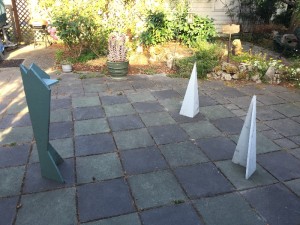
The highest elevation in the state is actually 535 feet, so Louisiana is 30 times more level than my Chessboard.
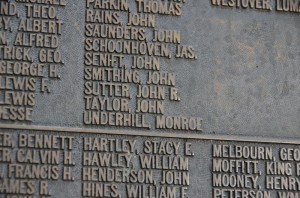 tal issues going on and trying to put myself in the place of the people involved in historical events is what I tend to find myself trying to do. Today, that effort to put ourselves in the shoes of the participants took on a special significance. Peg’s Great Great Grandfather, David Underhill, and 4 of his brothers all served in the Union army during the Civil War. They enlisted with regiments from 4 different states: New York, Illinois, Wisconsin, and Michigan. 3 of those 5 brothers were here at Vicksburg. After the Civil War memorials and road markers were put up all around th
tal issues going on and trying to put myself in the place of the people involved in historical events is what I tend to find myself trying to do. Today, that effort to put ourselves in the shoes of the participants took on a special significance. Peg’s Great Great Grandfather, David Underhill, and 4 of his brothers all served in the Union army during the Civil War. They enlisted with regiments from 4 different states: New York, Illinois, Wisconsin, and Michigan. 3 of those 5 brothers were here at Vicksburg. After the Civil War memorials and road markers were put up all around th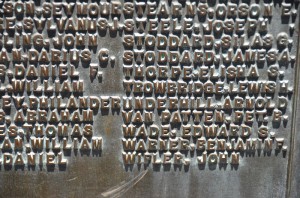 e area for each regiment that served here. We found the plaques listing the individual soldiers for 2 of the 3: Monroe and Arnold.
e area for each regiment that served here. We found the plaques listing the individual soldiers for 2 of the 3: Monroe and Arnold.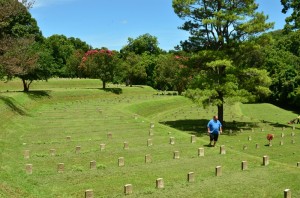 hills over which the battles were fought. The one we were looking for was several tiers down from the main road. After trying to climb down the tiers and barely making it back up we sought another way around and ended up walking almost half a mile to get all the way around the hill to the marker.
hills over which the battles were fought. The one we were looking for was several tiers down from the main road. After trying to climb down the tiers and barely making it back up we sought another way around and ended up walking almost half a mile to get all the way around the hill to the marker. 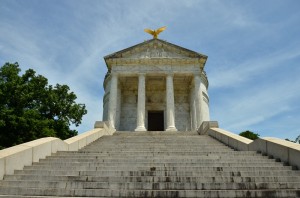
 Illinois soldiers who served here. I don’t often think about the fact that I was born in Illinois, but today for some reason that fact struck me. If I had been born 110 years earlier I would possibly have been one of those soldiers listed here.
Illinois soldiers who served here. I don’t often think about the fact that I was born in Illinois, but today for some reason that fact struck me. If I had been born 110 years earlier I would possibly have been one of those soldiers listed here.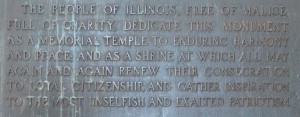

 sophisticated math was involved. The mound was built by carrying baskets full of soil from nearby areas up the mounds and building the structure layer by layer. With baskets of soil weighing about 50 pounds each the estimate is that it took about 15 million baskets full to build just the one mound.
sophisticated math was involved. The mound was built by carrying baskets full of soil from nearby areas up the mounds and building the structure layer by layer. With baskets of soil weighing about 50 pounds each the estimate is that it took about 15 million baskets full to build just the one mound.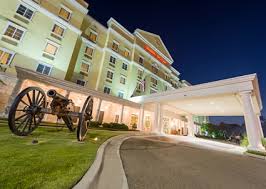
 es covers a lot of history but mostly a large number of old plantation sites in this area. We visited one specific site at the Oakley Plantation. This part of our country’s history is so sad. I have a hard time understanding the attraction that some people have to this era. Being here while so many conversations are going on about he confederate flag is very odd. The argument I have heard on news shows several times in the past week is that the Confederate flag is not about racism, it is about states’ rights. But I have to ask when I hear that phrase, “States’ rights to do what?” The civil war wasn’t fought over states’ rights to build roads, the right to provide schools or hospitals for citizens, or about how a state generally chooses to tax or spend its money. It was specifically over the “states’ right” to continue a system of support for one group of people to enslave another group of people and treat them as property. I don’t know if the confederate flag defenders don’t get that or if they don’t want to get that. The confederate flag is part of history but I have a hard time seeing how it should be the official part of any level of government anywhere in the currrent day United States.
es covers a lot of history but mostly a large number of old plantation sites in this area. We visited one specific site at the Oakley Plantation. This part of our country’s history is so sad. I have a hard time understanding the attraction that some people have to this era. Being here while so many conversations are going on about he confederate flag is very odd. The argument I have heard on news shows several times in the past week is that the Confederate flag is not about racism, it is about states’ rights. But I have to ask when I hear that phrase, “States’ rights to do what?” The civil war wasn’t fought over states’ rights to build roads, the right to provide schools or hospitals for citizens, or about how a state generally chooses to tax or spend its money. It was specifically over the “states’ right” to continue a system of support for one group of people to enslave another group of people and treat them as property. I don’t know if the confederate flag defenders don’t get that or if they don’t want to get that. The confederate flag is part of history but I have a hard time seeing how it should be the official part of any level of government anywhere in the currrent day United States.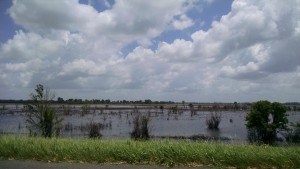 l today as we just managed to finish our day before a thunder storm rolled through the area.
l today as we just managed to finish our day before a thunder storm rolled through the area. otel was this sign. We had a great dinner and I told the waitress I had only one complaint. Their prime rib is so good I can never bring myself to try anything else on the menu.
otel was this sign. We had a great dinner and I told the waitress I had only one complaint. Their prime rib is so good I can never bring myself to try anything else on the menu.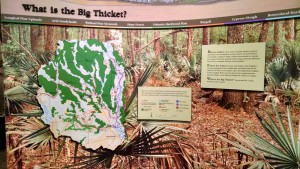 he day traveling in our air-conditioned car. This part of the country is so lush and green. It is really quite beautiful. We learned at the Big Thicket that for many years the Thicket was home to relatively few people, but that they could live a pretty reasonable life totally in the woods. The area is full of such a diverse range of plants, trees, birds, insects and animals that resourceful people could live a very self-sustained life just from the resources around them. In addition to using natural items for food and clothing and shelter, many medicines could be obtained from the Thicket.
he day traveling in our air-conditioned car. This part of the country is so lush and green. It is really quite beautiful. We learned at the Big Thicket that for many years the Thicket was home to relatively few people, but that they could live a pretty reasonable life totally in the woods. The area is full of such a diverse range of plants, trees, birds, insects and animals that resourceful people could live a very self-sustained life just from the resources around them. In addition to using natural items for food and clothing and shelter, many medicines could be obtained from the Thicket.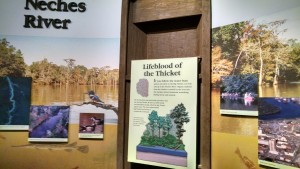 t the people living in the Big Thicket was that many of us today might look upon such an existence as a pretty low level hard scrabble way of life, but they definitely lived according to Milton Wrights advice. Not needing or expecting support or help from anyone else. Of course we do not live in a world where everyone ascribes to that approach. At the point at which it was realized that the Big Thicket contained Big Timber and Big Oil, then Big Money stepped in, booted out many of the people living there
t the people living in the Big Thicket was that many of us today might look upon such an existence as a pretty low level hard scrabble way of life, but they definitely lived according to Milton Wrights advice. Not needing or expecting support or help from anyone else. Of course we do not live in a world where everyone ascribes to that approach. At the point at which it was realized that the Big Thicket contained Big Timber and Big Oil, then Big Money stepped in, booted out many of the people living there
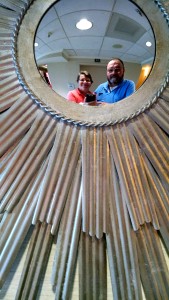 st part of travels to new places, whether it be physical travels to National Parks, or intellectual travels to other places and times like 1903 at Kitty Hawk, is when we can use those new experiences to reflect on ourselves and what we can do to make our work a better place.
st part of travels to new places, whether it be physical travels to National Parks, or intellectual travels to other places and times like 1903 at Kitty Hawk, is when we can use those new experiences to reflect on ourselves and what we can do to make our work a better place.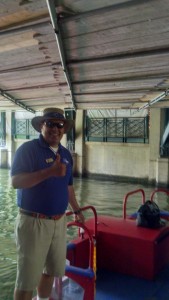 Joseph D. He was a our tour guide on a river boat ride around the river walk area of downtown San Antonio. Great tour, reasonable price, and great tour guide. We learned a lot and had many good laughs along the way. I hope Seattle can learn a few things from San Antonio as the city tries to figure out what to do with it’s waterfront after the viaduct comes down. Between Baltimore Harbor and the San Antonio river walk Seattle could learn some good lessons.
Joseph D. He was a our tour guide on a river boat ride around the river walk area of downtown San Antonio. Great tour, reasonable price, and great tour guide. We learned a lot and had many good laughs along the way. I hope Seattle can learn a few things from San Antonio as the city tries to figure out what to do with it’s waterfront after the viaduct comes down. Between Baltimore Harbor and the San Antonio river walk Seattle could learn some good lessons.
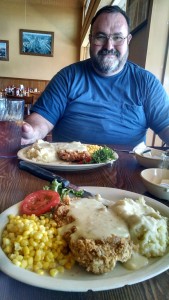

 ential homes when we were living in DC so are continuing to see others as we travel. In addition, George W is a distant cousin of mine. My only comment is that contrary to Wilbur Wright’s advice we don’t have any choice about who are parents or our blood relatives are.
ential homes when we were living in DC so are continuing to see others as we travel. In addition, George W is a distant cousin of mine. My only comment is that contrary to Wilbur Wright’s advice we don’t have any choice about who are parents or our blood relatives are.